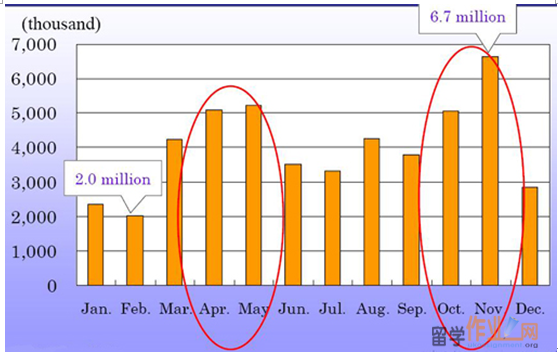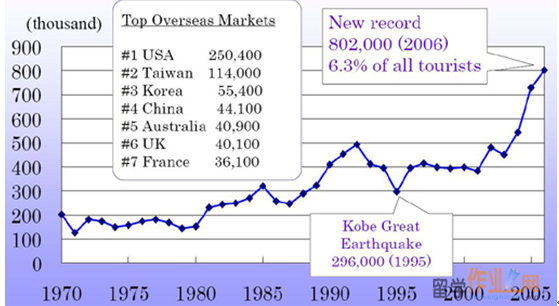|
Introduction
Secondary Research The secondary research method used here are textbooks and website informations.
Primary Research
THE FEATURE OF CULTURAL TOURISM IN KYOTO
Introduction
The aim of this chapter is to provide an overview of the characteristic feature of Kyoto cultural tourism, identity which stages it is in by using the Tourism Area Life Cycles (TALC) on the base of some official figures.
The Feature of Cultural Tourism in Kyoto
It flourished as the centre for Japanese politics, economy and culture for some 1,200 years, until the capital functions were transferred to Tokyo in the mid-19th century. There are many temples and shrines in Kyoto that were built during this long period that still remain there today. Thirteen temples, three shrines and the Castle are all registered as world heritage sites along with large numbers of historical buildings, cultural festivals and events, and traditional industries. The Imperial Court culture of the Kyoto aristocrats, as portrayed in Japan’s oldest novel, The Tale of Genji, became the foundation of the Japanese aesthetic sense. In addition, it is rich in intangible heritages, three artistic expressions have been proclaimed Masterpieces of the Oral and Intangible Heritage of Humanity: the Nôgaku Theatres (2001), the Ningyo Johruri Bunraku Puppet Theatre (2003) and the Kabuki Theatre (2005). Kyoto is also the center of Japan's religious culture.
Kyoto has been regarded as the cradle of Japanese culture and the most attractive cultural tourism destination in Asia by its both tangible and intangible cultural-historical features. According to an “Overseas Visitor Satisfaction Survey 2006-2007” (Japan National Tourist Organization annual report), Kyoto was the most recommended attraction in Japan. One of the most worldwide popular travel website “tripadvisor” put Kyoto on the number second of “Top 10 Culture & Sightseeing Destinations in Asia” and number seventeenth of “Top 25 Destinations in the World chosen by Europeans” of their annual rating: TRAVELERS’ CHOICE AWARS 2010 – THE BEST DESTINATIONS. The website recommended as: “Only Rome has more World Heritage Sites than the former Japanese capital. But happily unlike Rome, Kyoto maintains its calmness and romance even among throngs of summer tourists.” Kyoto also be choiced as the one of the “Top 10 Food & Wine Destinations in Asia” on number seventh and is the number six of “Top 10 Romance Destinations in Asia” (tripadvisor, 2010). “To choose the low season – winter, and touch the depth of Japanese culture all you want; to maximize the currency rate merit and enjoy the high cost performance of a stay in Japan; to take advantage the great transportation convenience of Kyoto and use it as your base of tourism in Japan.” (Kyoto Travel Guide, 2010)
Figure 2 presents the number of overseas visitors going to Kyoto from 1970-2006 and the top seven nations rating. Apparently, the number of visitors go to Kyoto has been keeping increase during this 36 year period, except in 1995 when the Kyoto area hit by an earthquake and then the figures reached the highest yet 2006. Figure 2 also shows that nearly forty-percent of all visitors who stay in Kyoto are Americans, making America the biggest exporter of Kyoto tourists. Butler’s (2005, pp.5-8) Tourism Area Life Cycles (TALC) model explores five main stages and an additional one to identify a destination’s status, which are exploration, involvement, consolidation, stagnation, decline, then rejuvenation may occur. As an instrument of Butler’s theory, tourism in Kyoto could be recognized as an experiencing between the consolidation and stagnation stage. According to Butler’s Tourism Area Life Cycles that: “As the consolidation stage is entered the rate of increase in numbers of visitors will decline, although total numbers will still increase with marketing, information dissemination, and further facility provision, a major part of the area’s economy will be tied to tourism. As the area enters the stagnation stage the peak numbers of visitors will have been reached.”
Some of the facts and figures above reveal that in the last three decades Kyoto tourism has stability in its growth apart from the negative affect from some of the natural disasters. Therefore, “Life cycles of regions are influenced by a multitude of commercial, government, human and other activities.” (Butler, 2005, p.60) However, even though the cultural tourism in Kyoto is in a stable stage, the consolidation stage still needs to develop the destination and improve performance to fight stagnation and decline.#p#分页标题#e# |
 |
|||
| 网站地图 |



